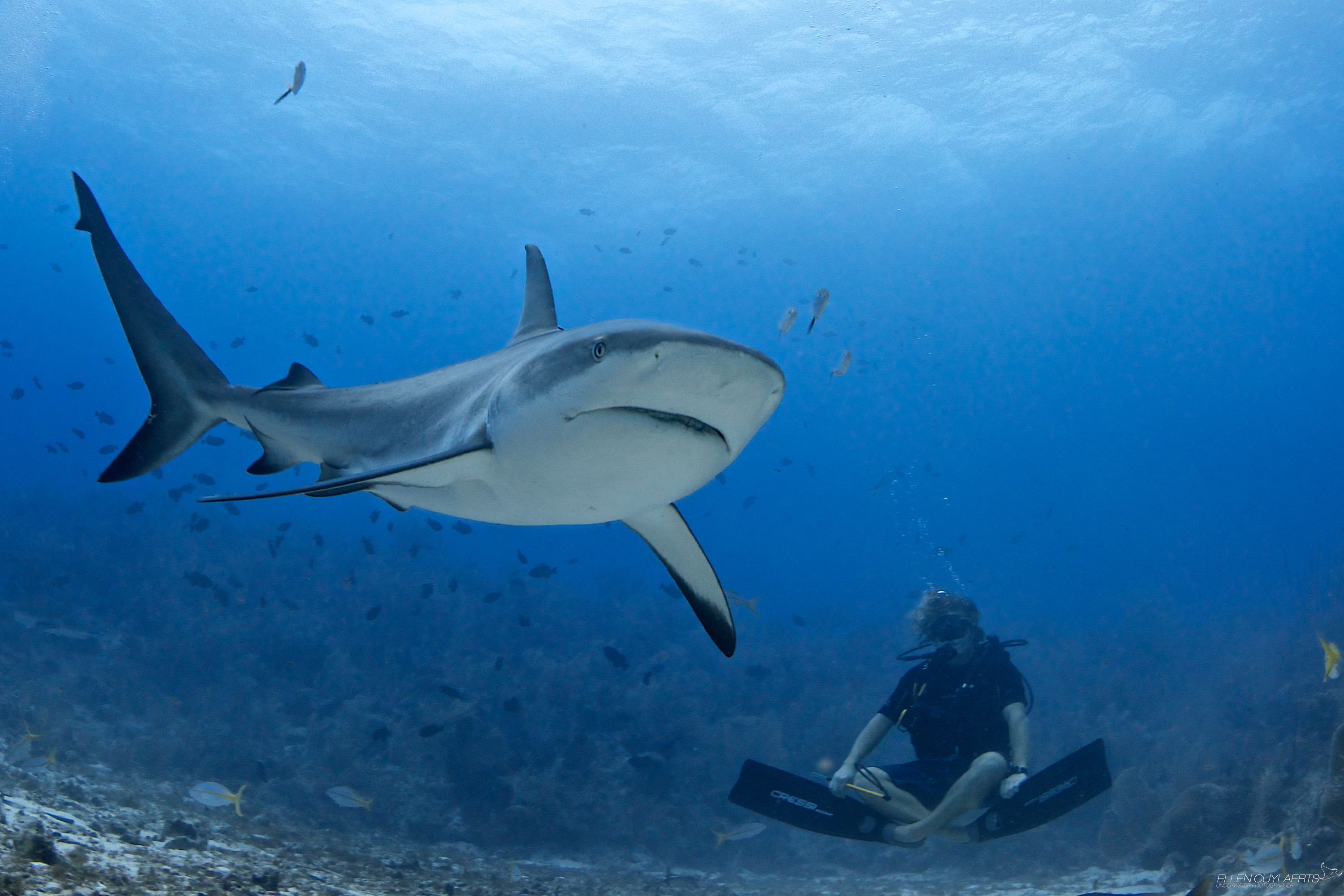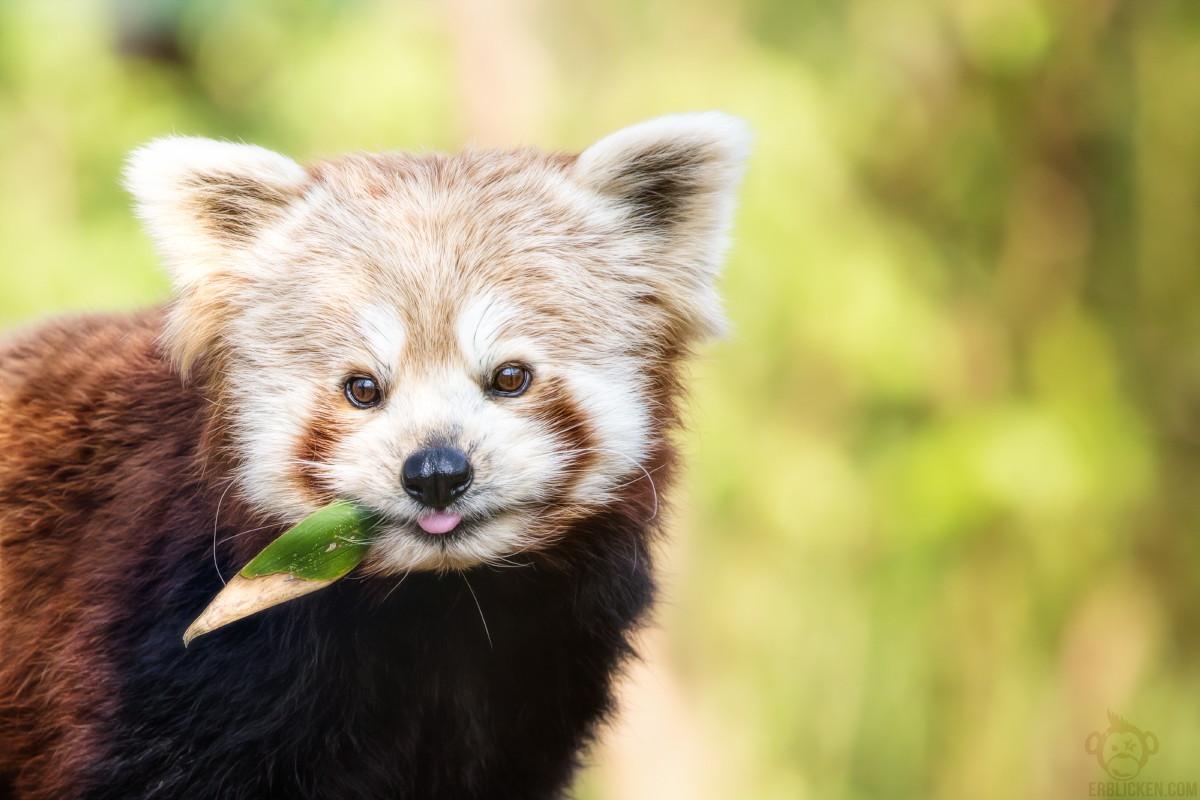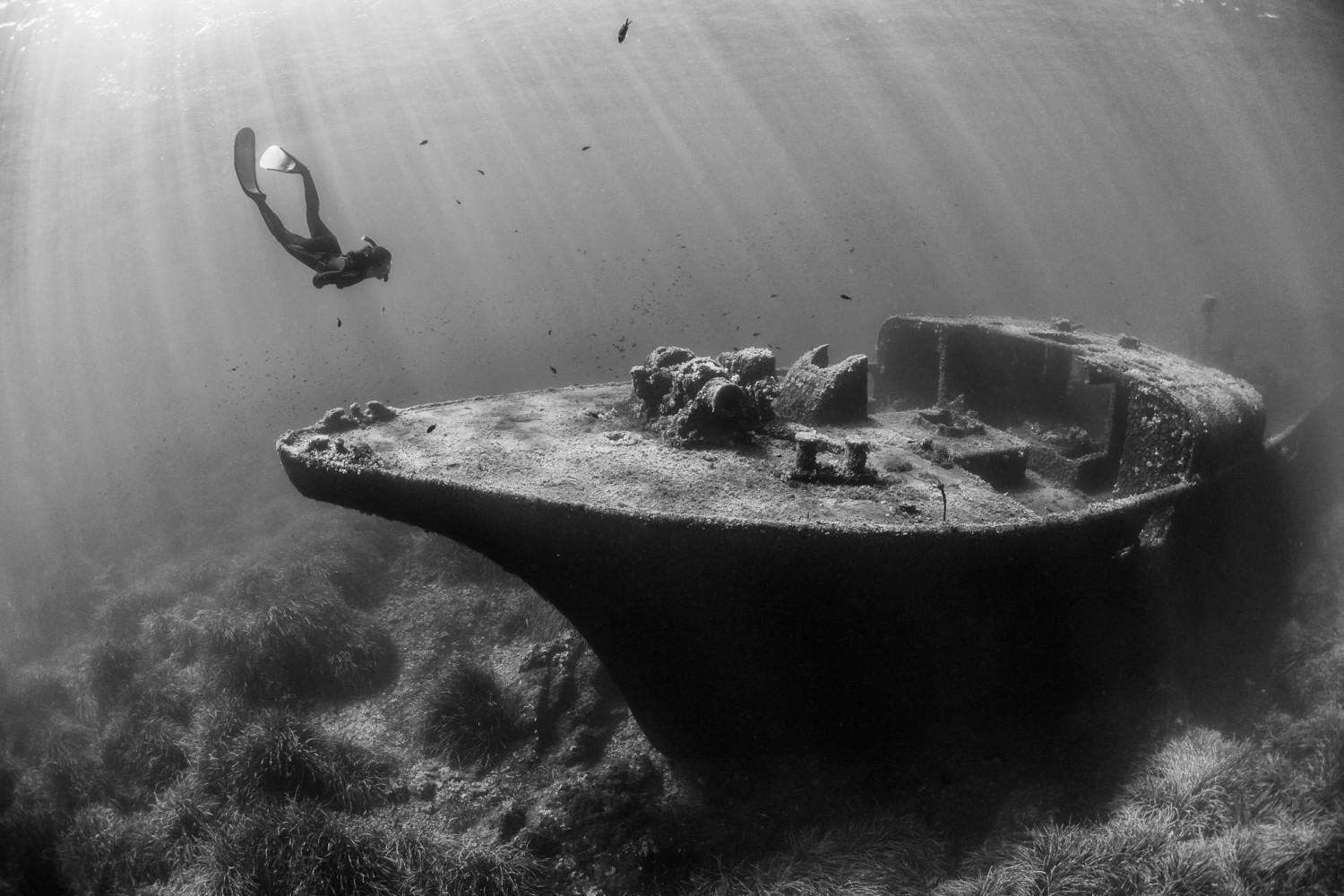Ellen Cuylaerts would like to change the way you see sharks. With the passion, care, and technique this diver and photographer puts into her underwater photographs, it seems to work. Just take a look at her thought-provoking “Shark Buddha”, where we get a serene portrayal of sharks and human, peacefully inhabiting the same space. And we’ve been enthralled with her body of work ever since, capturing unique pictures of sharks and other marine life to promote the preservation and protection of these species.
In our exclusive interview with Ellen Cuylaerts, she talks about her close encounters with sharks, the most photogenic dive spots, and how she got started with diving and photography. Plus, for those that are curious or already divers—she reveals her expert tips for photographing sharks in the deep. Scroll down to read on and see more jaw-dropping images of sharks swimming with people!
Hi Ellen! Can you tell us a little more about yourself?
ELLEN CUYLAERTS: I was born in 1970 and I have a Master’s degree in History & Education. I love reading, art, culture, music, and everything that is a feast for the senses. When I was living in my home country Belgium, I worked in IT, but I started working as a field expert volunteer in autism after my kids were diagnosed with Asperger syndrome. I started homeschooling them, and that was the trigger for our family to leave Belgium and move closer to nature. In 2009, we relocated to Grand Cayman in the Caribbean. The new environment—close to the ocean—was a blessing.
How did you get into underwater photography? Were you a diver first before a photographer, or was it the other way around?
ELLEN: Having moved to Grand Cayman, our pace of life slowed down. In 2011, I started diving regularly, followed very quickly by picking up an underwater camera. I was always interested in photography, but when I was younger I was limited by the money of buying film and developing images. My first camera just gathered lots of dust. As a diver who is also a parent, I wanted to keep it safe and schooled myself in all recreational diving matters, which made me well aware of my surroundings in the water. So the next challenge was all about multi-tasking—I can’t help it, I’m a woman—and I started capturing my dives with underwater photography in August 2011. After that, there was no way back. I did a workshop with marine biologist and top underwater photographer Dr. Alex Mustard after 6 months of shooting. I wanted to be well-prepared. After an intensive workshop, the images I took improved each time I went on a shoot underwater. The photography bug hit me. When I have encounters with wildlife, I try not to capture just the animal but the emotions that I experience at that moment, trying to touch hearts, so people will love and protect what needs protection.
Which particular locations in the world are your most favorite to photograph underwater?
ELLEN: With its warm blue water and great visibility, the Caribbean sea is a bliss to shoot in. You’re certain to have big animal encounters like sharks in the Bahamas or whales in Dominica. My next travels will bring me to the Arctic. I do look forward to exploring it with the different water color, and the amazing light and reflections of icebergs underwater. The cold will be a challenge, but challenges don’t scare me.
Can you talk a bit about your fascination with underwater wildlife, and particularly with sharks?
ELLEN: I’ve been fascinated by wildlife starting at a very young age. I loved watching David Attenborough’s natural history programs on TV. Whenever there were campaigns to save wildlife, I always signed up. I would donate my piggy bank savings to save the pandas, and so on. But marine life in particular fascinated me more. Maybe it was because of the silent underwater world, where all sounds were more subtle. But it’s also because I used to be afraid of water. I would’ve never been a part of the underwater world had I not conquered my fear. Don’t get me wrong, I loved being in the water and swimming, but being able to stand on a sandy bottom or staying close to the edge of a pool was was necessary to feel safe. The turning point in conquering this fear came when my dad passed away. He taught me that you can do whatever you dream of. When I finally had more me-time, I started diving and conquered my fear of water. And when I saw a flyer for a workshop with top shark photographer Amanda Cotton to photograph Oceanic Whitetip sharks in the pelagic blue waters of the Bahamas, I didn’t think twice. I jumped into the big unknown because I experienced the oceans getting out of balance. The need for shark protection was growing, and because images touch hearts, I wanted to be an instrument of spreading love for sharks.
Speaking of protecting sharks, as some as aware, today they are endangered and dwindling in numbers. How do you use your photography to raise awareness for the conservation of sharks?
ELLEN: We need sharks to keep the oceans healthy. They are the apex predator, hunting the weak, and this creates a strong and healthy fish life guarding the reefs, which is an essential for vivid oceans. More people are getting the message, and the battle against shark finning to produce shark fin soup is ongoing. But sharks are also a victim of certain fishing methods. After every shark bite, there follows a shark cull or hunt which is non-deserved. In my opinion, the reason behind it is fear. People and their actions are driven by fear, and the media feeds that fear. It sells well. Most images of sharks in the media are with mouths wide open, showing all teeth, spectacular titles above the pictures, and shark conservation efforts are forgotten. I do love every shark image, but I choose to picture them in a serene setting, like you would see them in their natural environment. They are majestic, serene animals, probably more afraid of us than we are of them. With my photography, I want to show the moments where sharks and humans share the same water and respect each other’s presence.
Do you think the popularity of shark chumming and feeding have an impact on sharks and their behavior?
ELLEN: I was very skeptical at first towards shark chumming and feeding. Instead of judging it, I wanted to experience the impact on sharks, so I booked a trip to Tiger Beach Bahamas and did some research. The fact is that the sharks that are being fed in the Bahamas have a wider range in migrating patterns than the ones not being fed in Florida. I also saw that the sharks are not really waiting on the divers, but every day you would get different sharks—some well-known to the dive operators, some new ones. I did not see any differences in their behavior in non-feeding situations. The good thing is that the success of shark photography helps spread the positive image of sharks, and the need for conservation and education.
Can you tell us about your most memorable experience diving with sharks?
ELLEN: During April 2014, my husband Michael Maes & I took our teenage kids, 16 and 14 years old, to Cat Island on a shark trip. There, we went snorkeling with Oceanic Whitetip sharks. On my birthday, they went in the water with four sharks and stayed calm. They had everything under control—no fear. It brought me to tears because it was a reminder that education about sharks is very essential. If you don’t feed fear, it will change to admiration and respect. To work on this change and give the next generation the key feels good!
What advice would you give someone who wants to work as an underwater marine photographer?
ELLEN: First, you have to control your dive skills, and know your limits. Second, you have to respect the wildlife. No picture is worth doing any damage! And finally, observe and learn—it will contribute to your images.
Now for something fun. What’s your underwater spirit animal?
ELLEN: I would be an orca. I admire their strong family bond. The sons stay with their mother and aunts, and help raise the calves by sometimes taking over the care, in order for mother orca to have some me-time. If our own human society would be that caring, it would be a happier place!
The helpful photo tips from Ellen Cuylaerts below are for those who are already divers, or those who are curious and willing to take up diving courses. Remember that while sharks are not mindless killing and feeding machines, they display curiosity and other complex social behaviors. Sharks shouldn’t be hunted or feared, but they should still be respected as the apex predators of the ocean. Therefore, before you can photograph and swim with them in the ocean, you will need to acquire knowledge of the species’ behavior and study proper dive skills first.
FOR DIVERS: 10 TIPS FOR PHOTOGRAPHING SHARKS
by Ellen Cuylaerts
On shark dives where chum (a mix of fish blood and interiors) is used, the sharks do come close which gives excellent photo opportunities. To prepare for a dive that involves photographing sharks, you have to get to know shark behavior—what to do and what not to do.
1. Prepare yourself by getting your heartbeat down. I always stay on the boat a while, meditate a bit, and visualize my encounters, until I’m perfectly calm. Only when I’m completely zen, I enter the water, super-focused. I owe this to the sharks! If something would happen because of a mistake I made, the sharks would be blamed, and I will not allow that to happen.
2. Act strong and keep eye contact. Since sharks normally hunt weak or sick fish, be careful not to make sudden splashing movements, like a fish that has been caught.
3. Dress in a black wetsuit and fins. Pink, yellow, or blue might get you more frisky sharks which can bring some discomfort or raise the heartbeat.
4. Wear gloves. You don’t want the shark to think your hand is a tasty bite.
5. Be calm or get out of the water. I’ve experienced divers panicking while surrounded by sharks. Some species pick it up, and will target that person. Not by biting of course, but by bumping. It’s their way of checking out if the possible prey is weak. You cannot allow a shark to bump you. Inform yourself about shark behavior and specific behavior of the shark species you dive with. It makes you better prepared.
6. Get to know your camera before you dive with it and find yourself between sharks. You cannot take time to change settings while watching through your viewfinder. You need to keep eye contact, and your eyes have to be on the sharks the whole time.
7. Work on your stamina before a trip with big animals. Some encounters are at the surface; with surface current, you’ll want to stay close to the boat. Some encounters in the water column are under tricky conditions. Being out of breath after five minutes does not help keeping your calm.
8. I shoot sharks with a fisheye lens (16mm Nikkor or 15 mm Sigma) and try to work on proper alignment to make it look natural, and get the whole shark in the image.
9. I use short strobe arms because the conditions getting in and out of the water are sometimes challenging. The last thing I need is to worry about entangled gear. With short strobes arms, I push my strobes back a bit, and turn them outwards on low power. Just a little add of strobe, lights up the sharks’ white bellies, and will give you crisper images.
10. Prepare yourself for weather days; days of no diving. Most shark dives are far from the shore, and it’s not always possible nor safe for boats and divers to go in the water. If you know what to expect, you’ll find it easier to deal with weather days, which is easier on the group. Remember that any encounter is a big gift, and nature can not be directed.
Scroll down for more of Ellen Cuylaerts’ photographs in the deep:
To see the rest of her work, follow Ellen Cuylaerts on 500px, or visit her website.
You can also connect with her on Twitter, Pinterest, or Instagram.
Currently, Ellen and her husband Michael Maes are working on a documentary about shark conservation, #Desperatesharkwife, to be released in 2016. All proceeds will go to education and conservation of sharks.
Got a question for Ellen about sharks, her work and process, or have some of your own photo diving adventures to share? Feel free to comment below!































Leave a reply